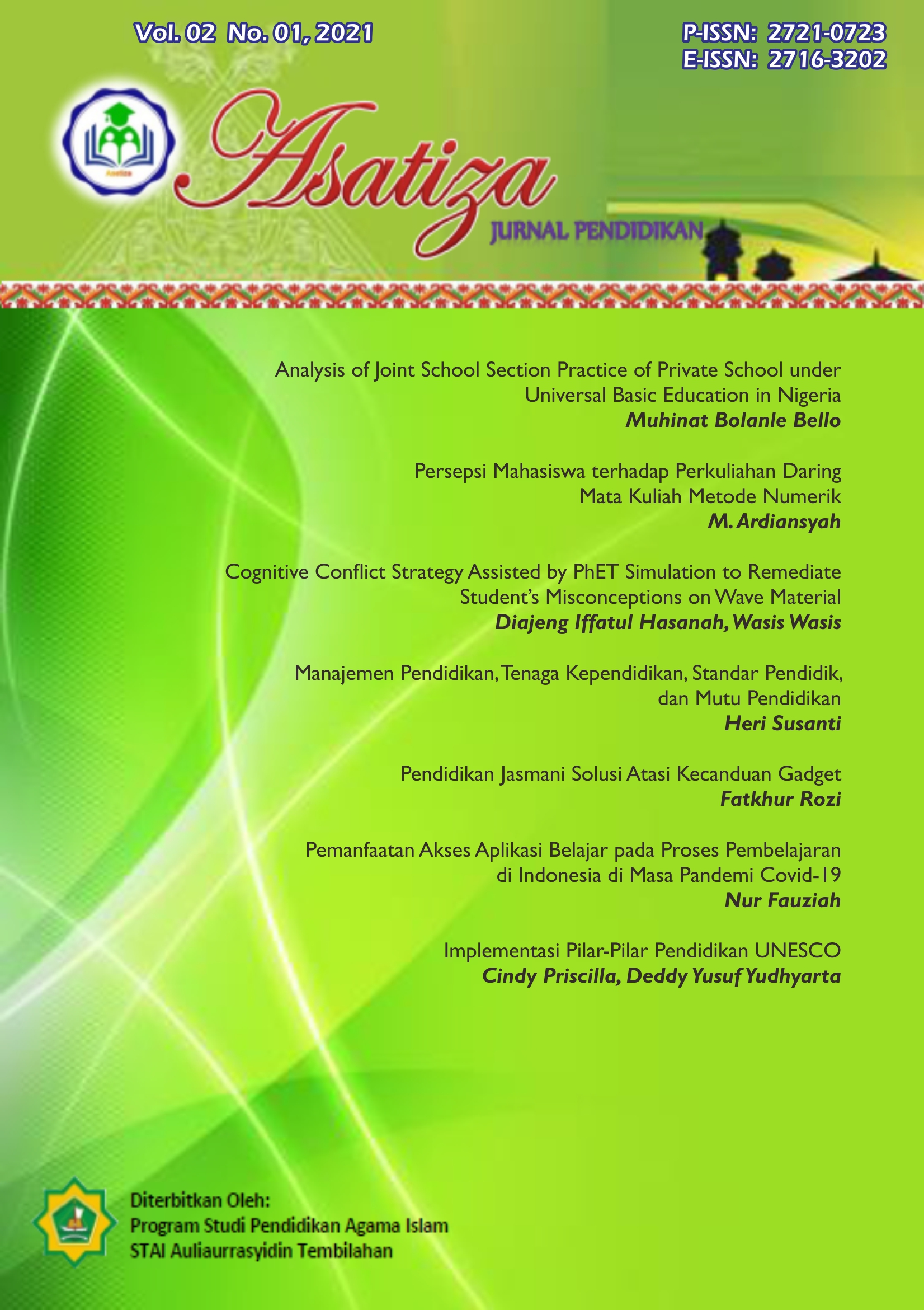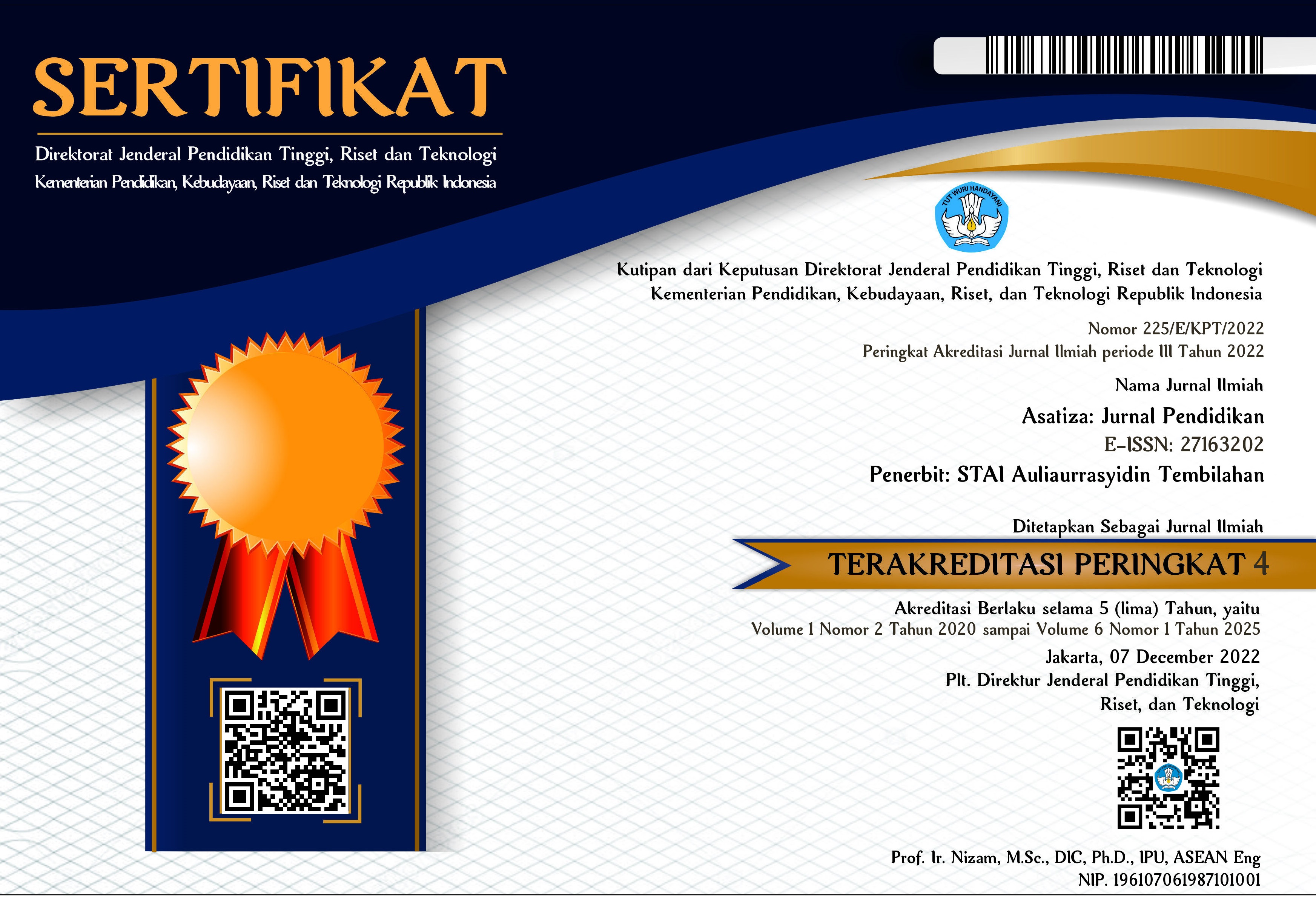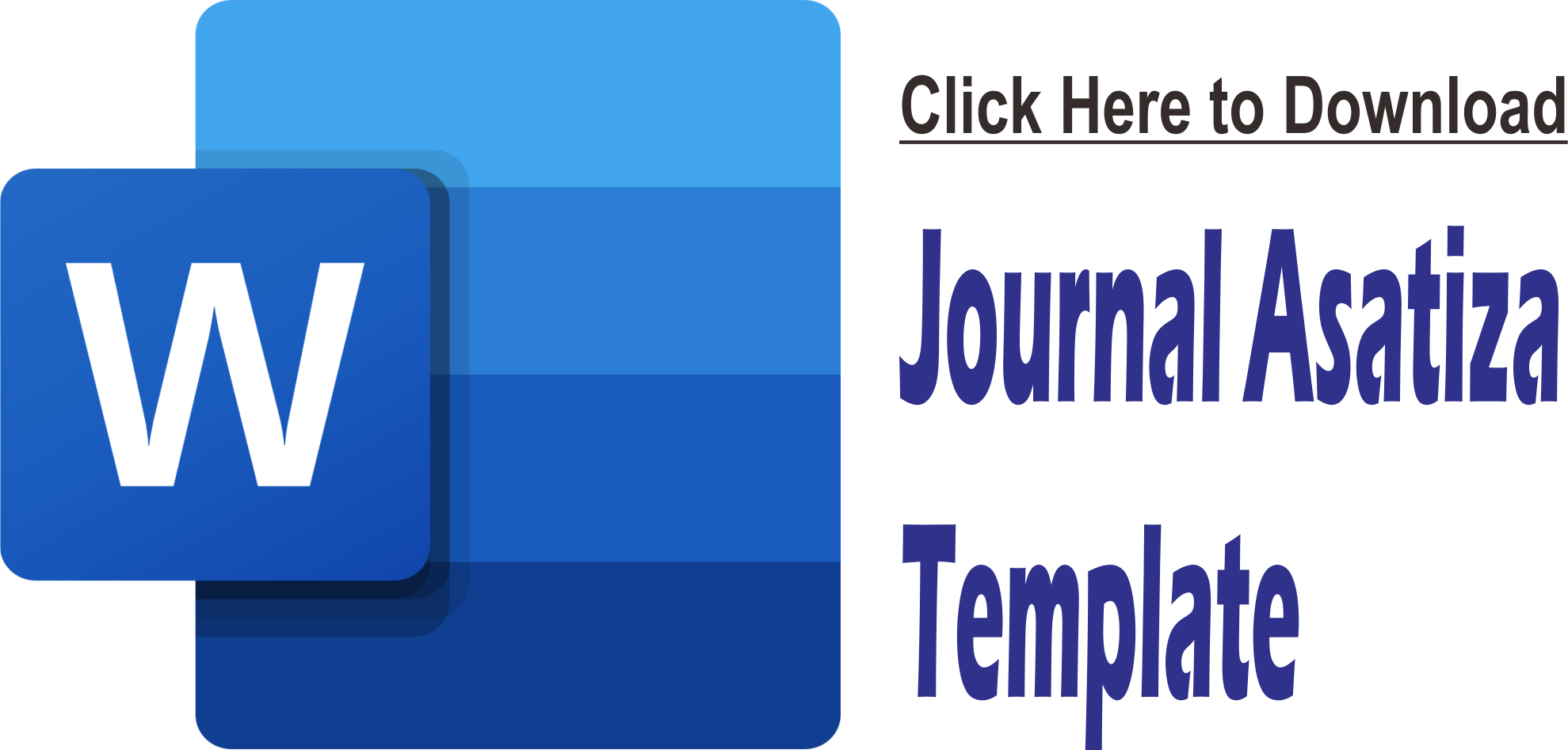Cognitive Conflict Strategy Assisted by PhET Simulation to Remediate Student's Misconceptions on Wave Material
DOI:
https://doi.org/10.46963/asatiza.v2i1.247Keywords:
Cognitive Conflict Strategy, Misconception, PhET Simulation, Wave MaterialAbstract
In this era, a misconception is one of the biggest challenges in education. Misconception is an understanding of a concept but incompatible with a scientific concept. This research aimed to describe the profile of students' misconceptions and to analyze the decrease of student misconceptions using a cognitive conflict strategy assisted by PhET Simulation. The kind of research is the pre-experimental category with the design of One Group Pre-Test and Post-Test. The sample of this research is a student of XII IPA 2 SMA Negeri 1 Bangkalan. The results of the pre-test showed that the average percentage of students who experience misconception is 53.53%. Based on the pre-test analysis, it was found 20 forms of conceptions that students had regarding the traveling wave material. After being given treatment using a cognitive conflict strategy assisted by PhET simulation, the post-test results of students who experienced misconceptions became 7.65%. There is a decrease in the average percentage of students who experience misconceptions in the pre-test and post-test results. It shows that the cognitive conflict strategy assigned by PhET simulation is effective in remediating the misconceptions of students on wave material.
Downloads
References
Arikunto, S. (2010). Prosedur Penelitian Suatu Pendekatan Praktik. Yogyakarta: Rineka Cipta.
Hamid, A. A. (2005). Salah Konsepsi Fisika dan Faktor-Faktor yang Mempengaruhinya. Seminar Nasional Penelitian, Pendidikan & Penerapan MIPA.
Kemendikbud. (2015). Materi Pelatihan Implementasi Kurikulum Jenjang SMA/SMK. Badan Pengembangan SDM Pendidikan, Kebudayaan dan Penjaminan Mutu Pendidikan.
Lee, G., Kwon, J., Park, S.-S., Kim, J.-W., Kwon, H.-G., & Park, H.-K. (2003). Development of an Instrument for Measuring Cognitive Conflict in Secondary-Level Science Classes. Journal of Research in Science Teaching, 40(6), 585-603. https://doi.org/10.1002/tea.10099.
Maulita, S. R., Sitompul, S.S., Mursyid, S. (2018). Efektivitas remediasi miskonsepsi siswa menggunakan strategi konflik kognitif pada materi hukum Archimedes di SMP. Jurnal Pendidikan dan Pembelajaran Khatulistiwa, 7(7), 9-18. https://jurnal.untan.ac.id/index.php/jpdpb/article/view/26758
Ma'rifah, M., Sumarni, W., Siadi, K. (2012). Keefektifan pereduksian miskonsepsi melalui strategi konflik kognitif pada pemahaman konseptual dan algoritmik. Chemistry in Education, 2(1), 42-48. https://journal.unnes.ac.id/sju/index.php/chemined/article/view/979
Mursalin, M. (2013). Model remediasi miskonsepsi materi rangkaian listrik dengan pendekatan simulasi PhET. Jurnal Pendidikan Fisika Indonesia, 9(1). 1-7. https://doi.org/10.15294/jpfi.v9i1.2574
Nawati, I., Saepuzaman, D., Suhandi, A. (2017). Konsistensi konsepsi siswa melalui penerapan model interactive lecture demonstration pada materi gelombang mekanik. Jurnal Penelitian Pembelajaran Fisika, 8(1), 32-38. https://doi.org/10.26877/jp2f.v8i1.1334
Nursiwin. (2014). Menggali miskonsepsi siswa pada materi perhitungan Kimia menggunakan certainty of response. Jurnal Pendidikan dan Pembelajaran Khatulistiwa, 3(1), 1-11. https://jurnal.untan.ac.id/index.php/jpdpb/article/view/4428
Nurulwati, N., Veloo, A., Ali, R M. (2014). Suatu tinjauan tentang jenis-jenis dan penyebab miskonsepsi Fisika. Jurnal Pendidikan Sains Indonesia, 2(1), 87-95. http://jurnal.unsyiah.ac.id/JPSI/article/view/7636
Sudjana. (2005). Metoda Statistika. Bandung: Tarsito.
Sugiyono. (2013). Metode Penelitian Kuantitatif dan R & D. Bandung: Alfabeta.
Suhandi, A., Sinaga, P., Kaniawati I., Suhendi, E. (2008). Efektivitas penggunaan media simulasi virtual pada pendekatan pembelajaran konseptual interaktif dalam meningkatkan pemahaman konsep dan meminimalkan miskonsepsi. Jurnal Pengajaran Matematika dan Ilmu Pengetahuan Alam. 13(1).
Tampubolon, T. (2001). Meningkatkan hasil belajar gelombang kelas il B cawu II SLTPN 13 Medan melalui pembelajaran Fisika model kontruktivis. Jurnal Pendidikan Science. 25(1). 30-39.
Widiastuti, A. S., Purwanto, J. (2019). Remediasi miskonsepsi pada materi gelombang bunyi dengan pendekatan konstruktivisme Metode 5E di SMA N 1 Turi. Prosiding SNFA Seminar Nasional Fisika dan Aplikasinya. https://jurnal.uns.ac.id/prosidingsnfa/article/view/35909
Yuafi, M. E. D., & Endryansyah, E. (2015). Pengaruh penerapan media pembelajaran PhET (Physics Education Technology) simulation terhadap hasil belajar siswa Kelas X TITL pada standar kompetensi mengaplikasikan rangkaian listrik di SMKN 7 Surabaya. Jurnal Pendidikan Teknik Elektro, 4(2), 407-414.
Yusran, Y. (2017). Remediasi miskonsepsi siswa menggunakan strategi konflik kognitif berbantuan simulasi Phet tentang rangkaian listrik di SMA. Jurnal Pendidikan dan Pembelajaran Untan, 6(5). Retrieved From https://jurnal.untan.ac.id/index.php/jpdpb/article/download/20121/16513
Zulfa, I., Setyarsih, W., Mukhayyarotin N. R. J. (2016). Dampak penerapan model pembelajaran interactive demonstration terhadap reduksi miskonsepsi siswa pada materi gelombang mekanik. Jurnal Inovasi Pendidikan Fisika, 5(3), 178-183 Retrieved fromhttps://jurnalmahasiswa.unesa.ac.id/index.php/inovasi-pendidikanfisika/article/view/211701/19892
Downloads
Published
Issue
Section
License
Authors who publish with this journal agree to the following terms:
1. Copyright on any article is retained by the author(s).
2. The author grants the journal, right of first publication with the work simultaneously licensed under a Creative Commons Attribution shareAlike 4.0 International License that allows others to share the work with an acknowledgment of the work’s authorship and initial publication in this journal.
3. Authors are able to enter into separate, additional contractual arrangements for the non-exclusive distribution of the journal’s published version of the work (e.g., post it to an institutional repository or publish it in a book), with an acknowledgment of its initial publication in this journal.
4. Authors are permitted and encouraged to post their work online (e.g., in institutional repositories or on their website) prior to and during the submission process, as it can lead to productive exchanges, as well as earlier and greater citation of published work.
5. The article and any associated published material is distributed under the Creative Commons Attribution-ShareAlike 4.0 International License











2.png)



